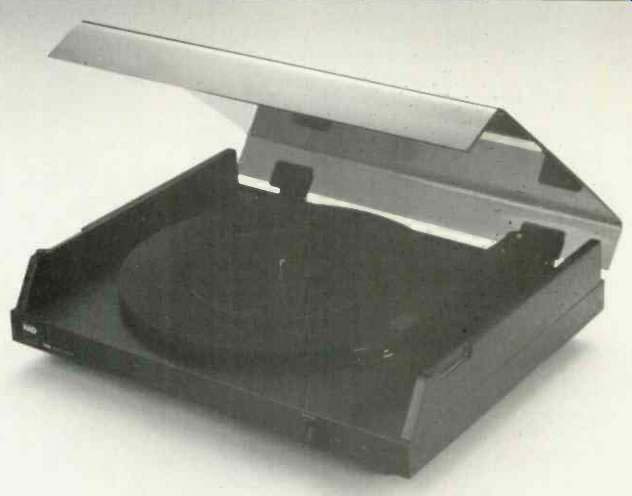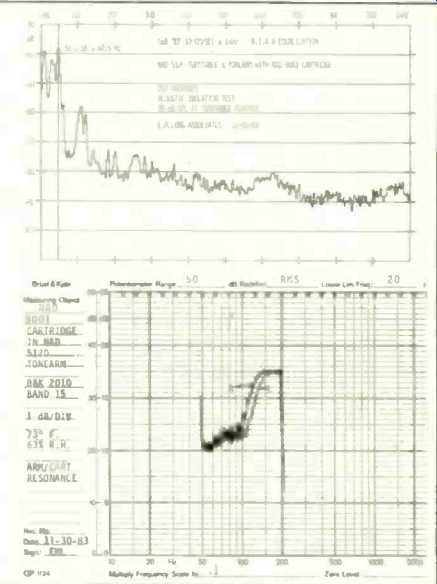
Manufacturer's Specifications:
Speeds: 33 1/3 and 45 rpm.
Wow and Flutter: 0.07% at 331/3 rpm, DIN 45-507.
Rumble: 70 dB, DIN 45-539-B.
Speed Inaccuracy: ± 0.5%.
Price: $248.00.
Company Address: 675 Canton St., Norwood, Mass. 02062.
The NAD 5120 turntable was subjected to a few tests and a brief listening evaluation. I used the NAD 9001 high-output moving-coil phono cartridge which was supplied with the turntable. This cartridge showed a gentle downward slope at the high frequencies and was down 4 dB at 20 kHz. No attempt was made to optimize the loading on the cartridge for this review. The response did extend well beyond 20 kHz and was down 10 dB at 40 kHz.

(top) Fig. 1--Acoustic isolation of the NAD 5120 turntable in a 95 dB SPL sound
field. (The 0 dB reference is 10 cm/S at 1 kHz.). (above) Fig. 2--Arm-cartridge
resonance, using NAD's 9001 phono cartridge. (Note the frequency multiplication
factor is 0.1.)
The NAD 5120 turntable and tonearm combination is definitely the result of some innovative engineering, and its various features are well executed. The heavy rubber mat, which is really the turntable platter since it contributes most of the mass, provides effective damping for both itself and the record. The speed was about 1% slow at 33 1/3 rpm, and there is no speed vernier control. The turntable torque under load is similar to the old AR turntable and is reasonably good. A control marked "Stop/Lift-Play" is located on the front of the base and can be operated with the lid down. It applies a breaking action to the platter as well as lifting the tonearm. At the end of a record, the tonearm is lifted and the turntable is stopped. There is a pilot light on the front of the base which lights when the turntable is running.
The tonearm is the most radical part of the NAD 5120. The thin, flat, ruler-like appearance seems very strange at first sight. The article in this issue mentions a dip at 140 Hz in the right channel; I measured a dip at about 170 Hz. The left channel did not have this dip. However, I did measure a dip of 4 dB at 47 Hz with the platter stationary during the tests of isolation from an external acoustic field. This shifted to 55 Hz with the turntable running. The tracking force, side thrust, and damping adjustment controls are well-marked and easy to use. NAD supplies a list of most cartridges with their tracking force and damping requirements, and I used the settings listed for the NAD 9001 cartridge, measured the tonearm/cartridge low-frequency resonance and verified the data shown in the article. The damping system works, and the result is a very firm, tight sounding bass.
The usual controlled mechanical-impulse tests were not made, but I did perform some quick tests by rapping my knuckle against the turntable base and slamming my fist against the platform upon which the turntable was resting; the stylus remained in the groove without skipping. During my brief listening, I found the sound to be brighter than I care for, but stereo imaging was quite good.
-Edward M. Long
Also see: NAD's Floppy Tonearm (Feb. 1984)
Understanding Tonearms (June 1980)
(adapted from Audio magazine, Feb. 1984)
= = = =